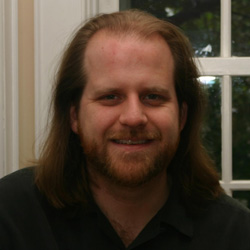Dr. Christopher R. Wren
The NewScientist article “Big brother” buildings offer less invasive security said
“Tracking people’s every move using buildings packed with motion sensors is more effective than CCTV, and less invasive to privacy, say researchers who tried the technique on their own colleagues.‘We want to have a god’s eye view of the entire space,’ says Yuri Ivanov of the Mitsubishi Electric Research Laboratories (MERL), who led the project with colleague Christopher Wren.
That may sound like the desire of George Orwell’s fictional ‘Big Brother’ in 1984. But the MERL system should actually preserve people’s privacy better than CCTV and make buildings safer and more secure, says Ivanov.”
Christopher R. Wren, Ph.D. is Principal Research Scientist, Mitsubishi Electric Research Laboratories (MERL). He invents perceptual and context aware systems for human interface and automation. He engages in the design and creation of novel perceptual technologies.
Chris is drawn to the junction between dynamic systems, people, and computers. He seeks to understand how systems change over time. He expresses that understanding in the form of perceptual machines. He enjoys helping others to know these systems through visualization. His recent award-winning work on the social patterns of large groups of people is but one manifestation of this drive. He has also worked on computer vision systems for human machine interface and dynamic simulations for graphics, haptics, and engineering.
Chris coauthored Dynamic Models of Human Motion, Automatic Pan-Tilt-Zoom Calibration in the Presence of Hybrid Sensor Networks, Understanding Purposeful Human Motion, Perceptive Spaces for Performance and Entertainment: Untethered Interaction Using Computer Vision, Self-configuring, Lightweight Sensor Networks for Ubiquitous Computing, Toward Scalable Activity Recognition for Sensor Networks, Similarity-based Analysis for Large Networks of Ultra-Low Resolution Sensors, and Worse is Better for Ambient Sensing.
His patents include Hierarchical processing in scalable and portable sensor networks for activity recognition, Traffic and geometry modeling with sensor networks, Methods of establishing a communications link using perceptual sensing of a user’s presence, Computer vision depth segmentation using virtual surface, and Videoconferencing method with tracking of face and dynamic bandwidth allocation.
Chris earned his Bachelor of Science at the Department of Electrical Engineering and Computer Science, Massachusetts Institute of Technology with the thesis “Dynamic Simulation of Large Systems: Trees Blowing in the Wind” and with a Minor in Cognitive Psychology. He earned his Master of Science at the Department of Electrical Engineering and Computer Science, Massachusetts Institute of Technology with the thesis Pfinder: Real-Time Tracking of the Human Body. He earned his Doctor of Philosophy at the Department of Electrical Engineering and Computer Science, Massachusetts Institute of Technology with the thesis Understanding Expressive Action with a minor in “Stochastics, Dynamics, and Recursive Filtering”.
Watch Pfinder: Real-Time Tracking of the Human Body and Ambient Intelligence for Better Buildings. Read Buildings could save energy by spying on inhabitants. Read his LinkedIn profile.
